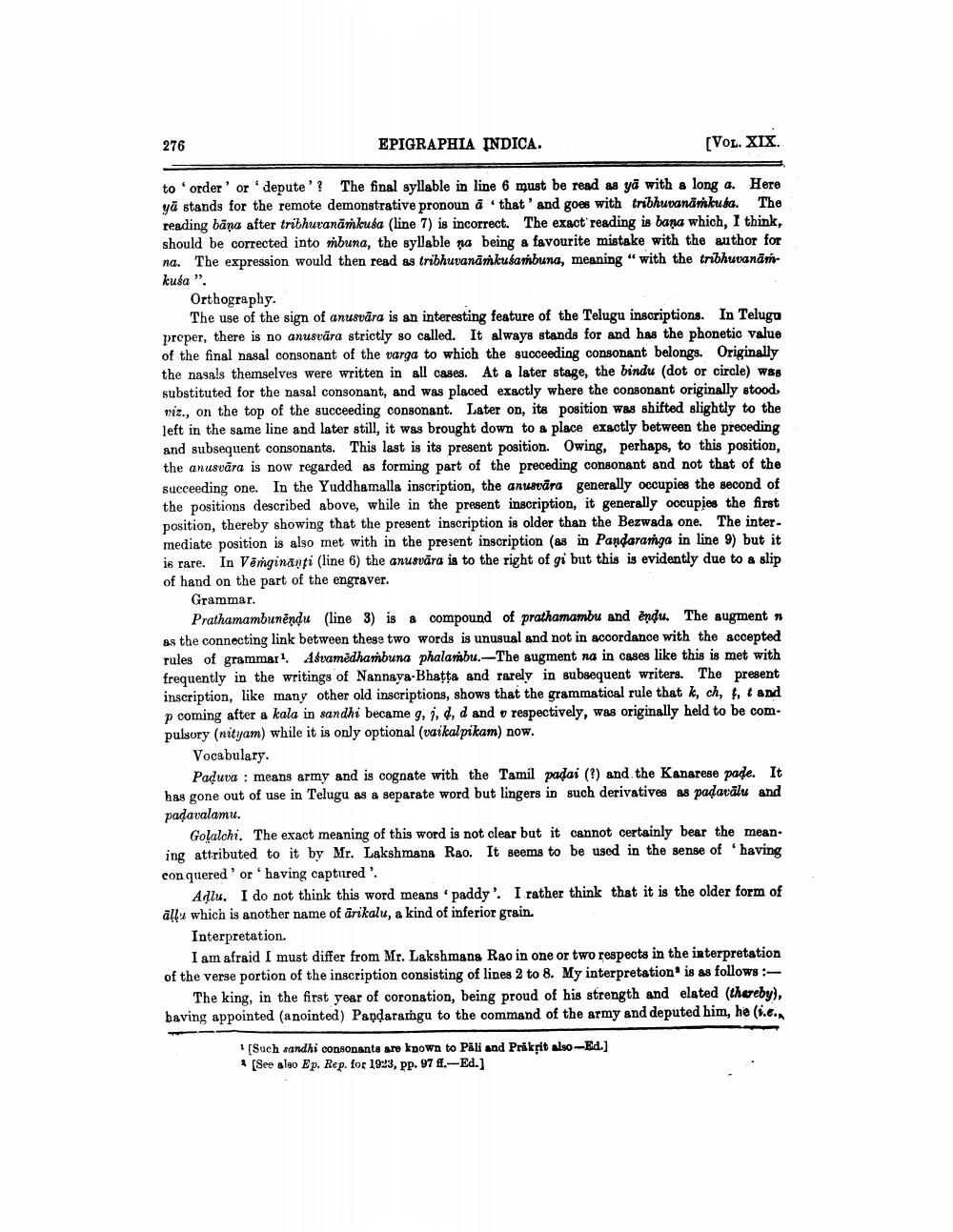________________
276
EPIGRAPHIA INDICA.
[VOL. XIX.
to order' or 'depute'? The final syllable in line 6 must be read as yā with a long a. Here yā stands for the remote demonstrative pronoun a that' and goes with tribhuvanāmkuta. The reading bāna after tribhuvanāmkusa (line 7) is incorrect. The exact reading is bana which, I think, should be corrected into mbuna, the syllable na being a favourite mistake with the author for na. The expression would then read as tribhuvanāmkusambuna, meaning "with the tribhuvanāṁkusa".
Orthography.
The use of the sign of anusvāra is an interesting feature of the Telugu inscriptions. In Telugu proper, there is no anusvära strictly so called. It always stands for and has the phonetic value of the final nasal consonant of the varga to which the succeeding consonant belongs. Originally the nasals themselves were written in all cases. At a later stage, the bindu (dot or circle) W&B substituted for the nasal consonant, and was placed exactly where the consonant originally stood. viz., on the top of the succeeding consonant. Later on, its position was shifted slightly to the left in the same line and later still, it was brought down to a place exactly between the preceding and subsequent consonants. This last is its present position. Owing, perhaps, to this position, the anusvāra is now regarded as forming part of the preceding consonant and not that of the succeeding one. In the Yuddhamalla inscription, the anusara generally occupies the second of the positions described above, while in the present inscription, it generally occupies the first position, thereby showing that the present inscription is older than the Bezwada one. The intermediate position is also met with in the present inscription (as in Pandaranga in line 9) but it is rare. In Vēnginanti (line 6) the anusvāra is to the right of gi but this is evidently due to a slip of hand on the part of the engraver.
Grammar.
Prathamambunēndu (line 3) is a compound of prathamambu and endu. The augment n as the connecting link between these two words is unusual and not in accordance with the accepted rules of grammar! Ašvamēdhambuna phalambu.-The augment na in cases like this is met with frequently in the writings of Nannaya-Bhatta and rarely in subsequent writers. The present inscription, like many other old inscriptions, shows that the grammatical rule that k, ch, t, t and p coming after a kala in sandhi became g, i, d, d and respectively, was originally held to be compulsory (nityam) while it is only optional (vaikalpikam) now.
Vocabulary.
Paduva : means army and is cognate with the Tamil padai (?) and the Kanarese pade. It has gone out of use in Telugu as a separate word but lingers in such derivatives as padarālu and padavalamu.
Go!alchi. The exact meaning of this word is not clear but it cannot certainly bear the mean. ing attributed to it by Mr. Lakshmana Rao. It seems to be used in the sense of having con quered ' or 'having captured'.
Adlu. I do not think this word means 'paddy'. I rather think that it is the older form of ally which is another name of ärikalu, a kind of inferior grain.
Interpretation.
I am afraid I must differ from Mr. Lakshmana Rao in one or two respects in the interpretation of the verse portion of the inscription consisting of lines 2 to 8. My interpretation is as follows :
The king, in the first year of coronation, being proud of his strength and elated (thereby), baving appointed (anointed) Pandaramgu to the command of the army and deputed him, he (i.com
[Such sandhi consonants are known to Pāli and Prükşit also-Ed.] [See also Ep. Rep. for 1923, pp. 97 ff.Ed.]




